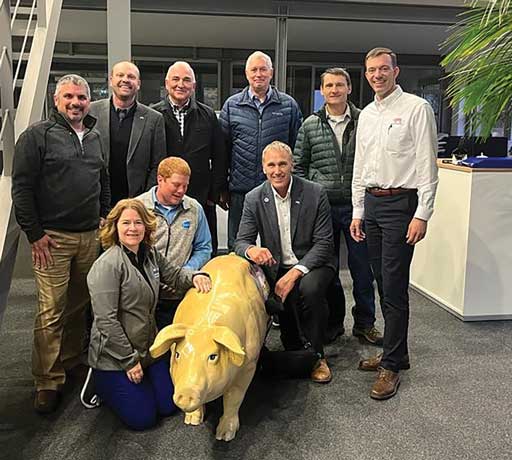African swine fever (ASF) prevention, preparedness, and response remains a top priority for the US pork industry. To gain valuable insights from international representatives, producers and veterinarians; state and federal authorities; and National Pork Board and National Pork Producers Council staff members traveled to Poland, Germany, and Belgium in November 2022. They also connected with officials and experts from Denmark and Romania.
Checkoff funds are used to ask important questions and discover strategies that may aid a foreign animal disease (FAD) outbreak if it were to occur in the United States. “There is value for producers and veterinarians to learn about how countries have been impacted by ASF and hear success stories,” says Dr Dustin Oedekoven, chief veterinarian for National Pork Board. “This information reinforces the industry ASF priorities set in 2022, and the key findings will help shape 2023 milestones and industry opportunities.”

Key to business objectives: Contact tracing is essential to regain export markets
The economic impact of a hypothetical ASF outbreak could cost the pork industry more than $50 billion over 10 years.1 Pork Checkoff funds are invested to promote business continuity and limit the halt of nearly 30% of pork products being exported.2
During the trip, attendees conversed with representatives from Poland to understand how the country regionalized ASF to regain some exports. However, no country has fully regained all its export markets following an ASF outbreak.
If an outbreak were to occur in the United States, AgView, a Checkoff-funded contact tracing application for pig movements, may help the US pork industry regionalize by providing pig movement data to state animal health officials (SAHOs) on day one.
“During an FAD outbreak, the ability to visualize current movements and export this information will be invaluable to the state veterinarian. Our goal is to quickly trace movements and minimize the impact of the outbreak,” says Dr Sara McReynolds, assistant animal health commissioner at the Kansas Department of Agriculture. “It will take us all working together to protect the industry. Having movement information, laboratory results, Secure Pork Supply plans and contact information all in one location will allow for a more efficient and timely response.”
The speed at which SAHO’s can determine where disease is, or more importantly where disease is not, provides critical information for establishing free regions where trade and commerce can resume. New features in AgView allow producers to continuously share location and movement information with SAHOs in real time.
“The ability for peacetime sharing of movement data in AgView could have tremendous application for pork producers using swine production health plans to move pigs across state lines for production,” says Dr Patrick Webb, National Pork Board’s assistant chief veterinarian. “Sharing pig movements in AgView could serve the purpose of delivering the required interstate swine movement report in real time.”
Prevention and control
In countries with ASF, the control of FAD transfer through people and wild animals is a daunting but necessary task. Several countries visited outlined successful strategies:
- Belgium - Interrupted virus transmission in the wild boar population, effectively preventing infection in the domestic herd. Two years after identifying the first case in wild boar, they regained ASF-free designation by the World Organization for Animal Health (WOAH).
- Germany - Identified spread from multiple sources, including people and wild boar.
- Denmark - Prevention, or bio-exclusion, through construction of a fence on the German border, elimination of wild boar, and strict truck washes.
Animal health professionals can help protect the US industry from ASF and other FADs by designing and implementing effective biosecurity protocols and assisting with Secure Pork Supply plans, encouraging producers to track pig movements in AgView, and routinely submitting diagnostic samples to a veterinary diagnostic laboratory that is a member of the National Animal Health Laboratory Network and participates in the US Department of Agriculture’s active ASF and classical swine fever surveillance program.
Remember, contact state or federal animal health officials with concerns for increased mortality or unusual morbidity.
The threat of ASF to the US swine herd is significant, with costly consequences. For example, the unmitigated spread of ASF in Romania has resulted in a significant reduction in their domestic herd. In the United States, today’s prevention measures and preparation could aid in tomorrow’s response should an outbreak occur. The industry needs veterinarians and allied industries to arm producers with confidence in the collaborated effort to prevent, prepare for, and respond to an FAD outbreak based on a national strategy.
Connect with National Pork Board staff and producer leaders at events and conferences in 2023. Visit porkcheckoff.org to learn more about strategies to help protect the freedom to operate and maintain business continuity.
References
*1. Carriquiry M, Elobeid A, Swenson DA, Hayes DJ. Impacts of African swine fever in Iowa and the United States. Working paper 20-WP 600. March 2020. Accessed January 6, 2023. https://www.card.iastate.edu/products/publications/synopsis/?p=1300
*2. US Meat Export Federation. 2021 beef exports shatter previous records; pork export value also reaches new high. February 9, 2022. Accessed January 6, 2023. https://www.usmef.org/news-statistics/press-releases/2021-beef-exports-shatter-previous-records-pork-export-value-also-reaches-new-high
* Non-refereed references.
AgView is effective with endemic diseases
More and more, swine veterinarians are discovering features in AgView that provide situational awareness for how endemic diseases may be moving in their companies or client base. “AgView is unique because it provides an application where locations, movements, and lab results come together in one spot,” says Dr Oedekoven. “Being able to visualize, search and sort data provides a day-to-day value for logging into the system and keeping data current which is important to SAHOs too.”
